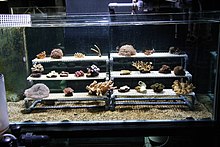Fragmentation (reproduction)
Fragmentation in multicellular or colonial organisms is a form of asexual reproduction or cloning, where an organism is split into fragments upon maturation and the spilted part becomes the new individual.
The organism may develop specific organs or zones to shed or be easily broken off. If the splitting occurs without the prior preparation of the organism, both fragments must be able to regenerate the complete organism for it to function as reproduction.
Fragmentation as a method of reproduction is seen in organisms such as
Fragmentation in various organisms
Molds,
. These hyphae obtain food and nutrients from the body of other organisms to grow and fertilize. Then a piece of hyphae breaks off and grows into a new individual and the cycle continues.Many
Plants
Fragmentation is a very common type of
- Production of specialized reproductive structures: A few plants produce adventitious plantlets on their leaves, which drop off and form independent plants, e.g. Tolmiea menziesii and Kalanchoe daigremontiana. Others produce organs like bulbils and turions.
- Easily lost parts that have high potential to grow into a complete plant: Some woody plants like the willow naturally shed twigs. This is termed cladoptosis. The lost twigs may form roots in a suitable environment to establish a new plant. River currents often tear off branch fragments from certain cottonwood species growing on riverbanks. Fragments reaching suitable environments can root and establish new plants.[2] Some cacti and other plants have jointed stems. When a stem segment, called a pad, falls off, it can root and form a new plant. Leaves of some plants readily root when they fall off, e.g. Sedum and Echeveria.
- Fragmentation is observed in nonvascular plants as well, for example, in liverworts and mosses. Small pieces of moss "stems" or "leaves" are often scattered by the wind, water or animals. If a moss fragment reaches a suitable environment, it can establish a new plant.[3] They also produce gemmae, for example in the splash-cups of Marchantia polymorpha,[4]that are easily broken off and distributed.
People use fragmentation to artificially propagate many plants via division, layering, cuttings, grafting, micropropagation and storage organs, such as bulbs, corms, tubers and rhizomes.
Animals
Coral

Many types of
Echinoderms
In echinoderms, the process is usually known as fissiparity (a term also used infrequently for biological fission in general). Some species can intentionally reproduce in this manner through autotomy. This method is more common during the larval editing stages.[10]
Disadvantage of this process of reproduction
As this process is a form of asexual reproduction, it does not produce genetic diversity in the offspring. Therefore, these are more vulnerable to changing environments, parasites, and diseases.
See also
References
- ^ "Fragmentation- Fragmentation in Animals and in Plants". BYJUS. Retrieved 2020-08-12.
- ^ Rood, S.B., Kalischuk, M.L., and Braatne, J.H. 2003. Branch propagation, not cladoptosis, permits dispersive, clonal reproduction of riparian cottonwoods. Forest Ecology and Management 186: 227–242. [1] Archived 2007-09-28 at the Wayback Machine
- ^ "Moss asexual reproduction". Archived from the original on 2006-09-27. Retrieved 2006-08-06.
- ^ Equihua, Clementina (1987). "Diseminación de yemas en Marchantia polymorpha L. (Hepaticae)". Cryptogamie, Bryologie, Lichénologie (in Spanish). 8 (3): 199–217.
- ISSN 1463-6395. Archived from the original(PDF) on 2016-03-04. Retrieved 2011-07-13.
- PMID 19067421. Archived from the original(PDF) on 2011-08-11. Retrieved 2011-07-13.
- PMID 10958900. Retrieved 2011-07-13.
- ^ Calfo, Anthony (2008). "Coral fragmentation: Not just for beginners". Reefkeeping Magazine. Reef Central. Retrieved 2015-05-03.
- Marine Biological Association. Retrieved 3 September 2018.
- ISBN 978-90-481-2766-5.
